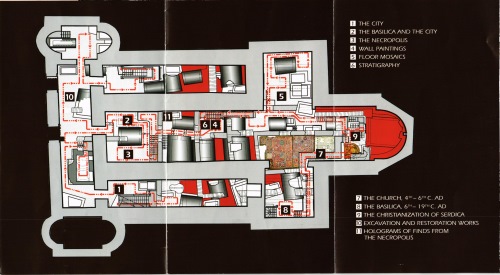Archeological level, Exhibition Route

In 45 AD this territory entered the newly formed Roman province of Thrace and the urban core of the future town was formed. During the reign of Emperor Trajan (98 – 117) Serdica obtained the rights of an urban centre.
The Basilica of Santa Sophia was erected in the heart of the eastern necropolis of Serdica. There has been discovered a large number of tombs of different type and construction, dating from 3th c. AD to the beginning of 5th c. AD, namely: stone sarcophagi, masonry tombs, tombs of stone plates with a flat roof, two- and multi-chamber brick tombs, etc. The most popular type in the late antiquity was masonry tombs with semi-cylindrical vault.
Rarely some tombs were painted. In tomb XVI from 4th c. AD the flowers are freely scattered, but no Christian symbols can be found. A typical example of this type of decoration is the tomb of Honorius discovered in the northwest of the Basilica of Santa Sophia and dated back to 5th c. AD. A Latin inscription in red letters on the lunette reads: Honorius, slave of Gog.
Besides sepulchral architecture, remains of several earlier Christian churches have been discovered.
The first church is a single-nave one with an apse and multi-coloured mosaic panels – in the apse (“The Paradise”) and in the nave (geometric pattern). The first church has three construction periods: as a martyrium, with initial square plan (second half of 311 AD. – the first half of 313 AD.); as a martyrium, extended after 313 AD. in the west direction; as paved with mosaic panels after the middle of 4th c. AD. The second (nave-and-two-aisles) basilica with an apse incorporated in the eastern wall was constructed at the and of 4th c. AD and has been used for a short time. Its entire floor was covered with polychrome mosaics, mostly with geometric and floral motifs. It was built at the very end of 4th – the beginning of 5th c. of The floor the third (nave – and – two – aisles) basilica, constructed at the beginning of 5th c. AD, was entirely covered with multi-colored mosaics of geometric and floral pattern. Most probably this church was destroyed by the great Huns’ invasion in the middle of 5th c. AD. The construction of the current nave-and-two-aisles cross-domed basilica of Santa Sophia with a transept and a two-story narthex could be dated to the end of 5th – the beginning of 6th c. AD.





